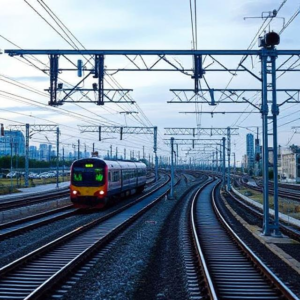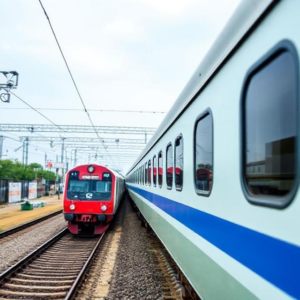IoT Integration in Railways
IoT stands for the Internet of Things. It refers to connecting everyday objects to the internet so they can send and receive data. In the case of railways, IoT integration means connecting various parts of the train system—like trains, tracks, stations, and signals—to the internet, so they can communicate with each other and provide useful information in real time.
Let’s break it down step by step.

1. What is IoT in Railways?
In railways, IoT is about using smart devices and sensors that collect data and share it over the internet. These devices could be attached to trains, tracks, signals, or even in the stations.
For example, trains can have sensors that track their speed, location, and engine condition. These sensors send data back to a central system, allowing operators to monitor the train in real time.
2. How Does IoT Work in Railways?
- Sensors on Trains: Sensors can be attached to different parts of the train, like the wheels, brakes, and engines. These sensors measure things like:
- Temperature (to check for overheating).
- Vibration (to detect if anything is wrong with the train’s parts).
- Fuel levels (to ensure the train doesn’t run out of fuel unexpectedly).
- Location (to track the train’s exact position).
- Sensors on Tracks and Stations: Tracks and stations can also have sensors that monitor:
- Track condition (to detect damage like cracks or wear).
- Weather conditions (to monitor if it’s safe for trains to operate, especially in snowy or rainy conditions).
- Passenger counts (to know how many people are waiting at a station or riding the train).
- Real-Time Communication: All this data is sent in real time over the internet to a central control system. This system collects and processes the data to provide insights into train and track conditions.
3. Benefits of IoT Integration in Railways
Here’s how IoT can make railways smarter and more efficient:
a. Predictive Maintenance
- What It Is: IoT can help predict when a train or track might break down before it happens.
- How It Works: Sensors track the condition of train parts, like engines or wheels. If the sensors detect something unusual, like a part that’s worn down or overheating, the system sends an alert. This means that problems can be fixed before they lead to a breakdown or delay.
- Why It’s Important: This prevents unexpected breakdowns and costly repairs, and it keeps the trains running smoothly.
b. Improved Safety
- What It Is: IoT can increase safety by continuously monitoring the trains and tracks.
- How It Works: Sensors on trains and tracks can detect things like train speed, braking distance, and track integrity. If something goes wrong, like a track becoming damaged or a train moving too fast, the system can alert the operators to take action immediately.
- Why It’s Important: It helps prevent accidents and ensures the train system is running safely at all times.
c. Real-Time Monitoring
- What It Is: IoT allows for continuous monitoring of the train’s condition and location.
- How It Works: The system knows exactly where every train is at all times. It can also track train speed, fuel levels, and even weather conditions. If there’s a problem, like a delay or a malfunction, the system will send alerts so the operators can take action quickly.
- Why It’s Important: It improves the efficiency of train operations, reduces delays, and helps with quick decision-making.
d. Better Passenger Experience
- What It Is: IoT can enhance the experience of passengers traveling by train.
- How It Works: Sensors can help train stations know when trains are due to arrive, how crowded the trains are, and how many seats are available. This information can be shared with passengers via apps or displays at the stations, so they can plan better and avoid overcrowding.
- Why It’s Important: Passengers will feel more comfortable knowing when the train is arriving and whether there are seats available, making the overall journey more enjoyable.
4. How IoT is Used in Different Areas of Railways
a. In Trains
- Maintenance: Sensors monitor the condition of train components, like engines, brakes, and wheels. If something needs fixing, the system sends a signal to maintenance workers.
- Energy Efficiency: By measuring fuel consumption and energy use, IoT helps optimize fuel usage and save energy.
b. On Tracks
- Track Health: Sensors monitor for issues like track cracks or damage that could lead to accidents. This allows for early repairs.
- Weather Monitoring: Weather stations along the tracks can detect extreme conditions (like ice or heavy rain) and alert operators to adjust train speeds for safety.
c. At Stations
- Passenger Tracking: IoT can help track how many passengers are waiting at a station or on a train. It can adjust train schedules to reduce overcrowding.
- Smart Ticketing: IoT-enabled systems can make ticketing more efficient by allowing passengers to buy tickets through apps or contactless cards.
5. Challenges and Solutions
While IoT offers a lot of benefits, there are a few challenges to consider:
a. Connectivity Issues
- Challenge: In remote areas or tunnels, it might be hard to get a good internet connection to send data.
- Solution: Satellites or advanced communication networks like 5G can be used to improve connectivity in these areas.
b. Data Security
- Challenge: Since IoT relies on data being sent over the internet, there’s a risk of cyberattacks or data breaches.
- Solution: Strong encryption, firewalls, and security protocols are needed to protect the data and prevent unauthorized access.
c. Cost of Implementation
- Challenge: Setting up IoT systems with sensors and devices on every train, track, and station can be expensive.
- Solution: The long-term savings from reduced maintenance, fewer delays, and better efficiency often outweigh the initial costs.
In Summary:
IoT Integration in Railways connects trains, tracks, stations, and other systems to the internet using sensors and smart devices. This helps improve safety, efficiency, and the overall passenger experience. IoT systems can monitor train conditions, predict maintenance needs, provide real-time data, and even improve energy use. While there are challenges like connectivity and security, the benefits of a smarter, safer railway system are worth it in the long run.
Keywords: IoT, Railway











